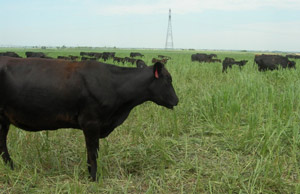Planning Annual Forage Systems
March 2016

With continued strong demand for summer pasture, some producers are looking at cropland alternatives to produce grazing forage. This typically involves planting cool- or warm-season forages and in many cases, double-cropping annuals. An important challenge in these systems is getting an extended, continuous period with available forage to be grazed. This can be achieved through using a combination of warm- and cool-season annuals.
Species Selection and Management
There are numerous cool- and warm-season annuals that can be used for forage. Cool- and warm-season species should be planted separately, but mixtures of several cool-season species could be planted, and similarly, mixtures of different warm-season species could be used.
Warm-Season Annual Grasses
Warm-season annual grasses can be planted in late spring or early summer to provide mid and late summer grazing or stockpiled and used for winter grazing. Sudangrass is a rapidly growing warm-season grass, with good regrowth potential. It usually contains lower levels of prussic acid than sorghum-sudangrass hybrids, but it is also slightly lower yielding.
Sorghum-sudangrass hybrids resemble sudangrass, but the hybrids are taller, have larger stems and leaves, and generally produce higher yields. However, it has a slower regrowth rate and is more likely to contain toxic levels of prussic acid. It can also become coarse and unpalatable if allowed to become too mature before grazing.
Pearl millet is another annual grass that could be grown for supplemental forage. It tends to have smaller stems and is leafier than the other grasses and it does not produce prussic acid. However, it has less regrowth potential than other summer annuals.
For more information on selection and management of warm-season (summer) annual grasses, see NebGuide G2183, Summer Annual Forage Grasses (PDF version, 341KB).
Cool-Season Annual Grasses
Spring small grain cereal grasses such as oats, spring triticale, spring barley, and spring wheat can be planted in early spring to provide late spring and early summer grazing or planted in mid or late summer to provide fall grazing. They will not survive over winter and thus, no spring grazing.
Generally, winter small grain varieties will not produce as much fall growth as spring small grain varieties. Winter small grains can be planted in the fall to provide earlier spring grazing than spring varieties planted in early spring.
Brassicas
Brassicas (turnips, kale, rape, etc.) can be high-yielding and high-quality. Due to their ability to scavenge nitrogen, they tend to have relatively high protein content. It is recommended that they be mixed with small grains for grazing. The most common use is for fall or winter grazing, but they can be planted in the early spring with spring small grains. Most brassicas have a high energy content even when mature. This quality is maintained later into winter than the small grains.
For more information on summer/fall planting of cool-season annuals, see NebGuide G2262, Annual Cool-Season Forages for Late-Fall or Early-Spring Double-Crop (PDF version, 1.1MB).
Fertilization
Annual forages must be fertilized to reach their yield potential. However, fertilizer application should be according to soil test recommendations. With warm-season annual grasses, nitrogen (N) is most often the limiting nutrient. Typically, 50 to 60 lbs. N per acre is needed at establishment. Additional nitrogen may be needed after the first grazing or haying to promote regrowth. Adequate rainfall or irrigation and favorable temperatures are needed with additional N fertilization to reduce nitrate risk. For cool-season annuals 50 to 60 lbs. N per acre is typically needed.
Irrigation
In central and western Nebraska, irrigation will increase yields and improve the reliability of forage production. More information on irrigation management for forage production can be found in NebGuide G2012, Forage Production with Limited Irrigation (PDF version, 860KB).
Page 1 | Page 2 | Page 3 | Page 4 || View all
Jerry D. Volesky
Range and Forage Specialist
Nebraska Extension
Mary E. Drewnoski
Beef Systems Specialist
Nebraska Extension